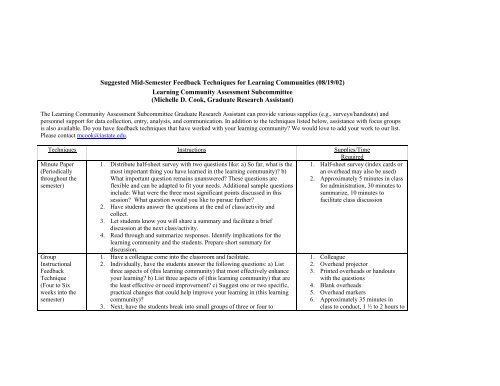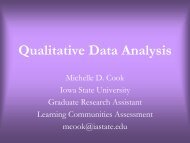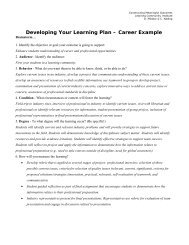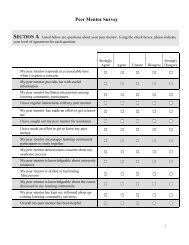Mid-semester Feedback Techniques (pdf) - Learning Communities
Mid-semester Feedback Techniques (pdf) - Learning Communities
Mid-semester Feedback Techniques (pdf) - Learning Communities
Create successful ePaper yourself
Turn your PDF publications into a flip-book with our unique Google optimized e-Paper software.
Suggested <strong>Mid</strong>-Semester <strong>Feedback</strong> <strong>Techniques</strong> for <strong>Learning</strong> <strong>Communities</strong> (08/19/02)<br />
<strong>Learning</strong> Community Assessment Subcommittee<br />
(Michelle D. Cook, Graduate Research Assistant)<br />
The <strong>Learning</strong> Community Assessment Subcommittee Graduate Research Assistant can provide various supplies (e.g., surveys/handouts) and<br />
personnel support for data collection, entry, analysis, and communication. In addition to the techniques listed below, assistance with focus groups<br />
is also available. Do you have feedback techniques that have worked with your learning community We would love to add your work to our list.<br />
Please contact mcook@iastate.edu.<br />
<strong>Techniques</strong> Instructions Supplies/Time<br />
Required<br />
Minute Paper<br />
(Periodically<br />
throughout the<br />
<strong>semester</strong>)<br />
Group<br />
Instructional<br />
<strong>Feedback</strong><br />
Technique<br />
(Four to Six<br />
weeks into the<br />
<strong>semester</strong>)<br />
1. Distribute half-sheet survey with two questions like: a) So far, what is the<br />
most important thing you have learned in (the learning community) b)<br />
What important question remains unanswered These questions are<br />
flexible and can be adapted to fit your needs. Additional sample questions<br />
include: What were the three most significant points discussed in this<br />
session What question would you like to pursue further<br />
2. Have students answer the questions at the end of class/activity and<br />
collect.<br />
3. Let students know you will share a summary and facilitate a brief<br />
discussion at the next class/activity.<br />
4. Read through and summarize responses. Identify implications for the<br />
learning community and the students. Prepare short summary for<br />
discussion.<br />
1. Have a colleague come into the classroom and facilitate.<br />
2. Individually, have the students answer the following questions: a) List<br />
three aspects of (this learning community) that most effectively enhance<br />
your learning b) List three aspects of (this learning community) that are<br />
the least effective or need improvement c) Suggest one or two specific,<br />
practical changes that could help improve your learning in (this learning<br />
community)<br />
3. Next, have the students break into small groups of three or four to<br />
1. Half-sheet survey (index cards or<br />
an overhead may also be used)<br />
2. Approximately 5 minutes in class<br />
for administration, 30 minutes to<br />
summarize, 10 minutes to<br />
facilitate class discussion<br />
1. Colleague<br />
2. Overhead projector<br />
3. Printed overheads or handouts<br />
with the questions<br />
4. Blank overheads<br />
5. Overhead markers<br />
6. Approximately 35 minutes in<br />
class to conduct, 1 ½ to 2 hours to
Plus Delta<br />
(Four to Six<br />
weeks into the<br />
<strong>semester</strong>)<br />
Goal Ranking<br />
and Matching<br />
(Early in the<br />
<strong>semester</strong>)<br />
compare answers and identify two or three common answers for each<br />
question.<br />
4. Have the students share their group answers with the class.<br />
5. Poll the class for agreement.<br />
6. Read through and summarize responses. Identify implications for the<br />
learning community and the students. Prepare short summary for<br />
discussion.<br />
1. Distribute one-page handout with the following questions: a) In terms of<br />
helping you learn – what’s working in the learning community b) What<br />
aspect of the learning community needs changing c) In terms of helping<br />
you learn – what are you doing as a student that’s working d) What are<br />
you doing as a student that needs changing<br />
2. Have students answer the questions at the end of class/activity and<br />
collect.<br />
3. Let students know you will share a summary and facilitate a brief<br />
discussion at the next class/activity.<br />
4. Read through and summarize responses. Identify implications for the<br />
learning community and the students. Prepare short summary for<br />
discussion.<br />
1. Have the students list their learning goals for the learning community.<br />
2. Next, ask them to rank the relative importance (1, 2, 3, etc.).<br />
3. Collect and let students know you will share a summary and facilitate a<br />
brief discussion at the next class/activity.<br />
4. Read through and summarize responses. Compare responses with<br />
intended outcomes. Identify implications for the learning community and<br />
the students. Prepare short summary for discussion.<br />
summarize, 15 minutes to<br />
facilitate class discussion<br />
1. One-page handout<br />
2. Approximately 15 minutes in<br />
class to conduct, 45 minutes to<br />
summarize, 15 minutes to<br />
facilitate class discussion<br />
1. Approximately 10 minutes in<br />
class to conduct, 30 minutes to<br />
summarize, 10 minutes to<br />
facilitate class discussion<br />
This document is developed from Angelo and Cross (1993) and Huba and Freed (2000).<br />
Angelo, T. A., & Cross, K. P. (1993). Classroom assessment techniques (2 nd ed.). San Francisco: Jossey-Bass.<br />
Huba, M. E., & Freed, J. E. (2000). Using feedback from students to improve learning. In Learner-centered assessment on<br />
college campuses: Shifting the focus from teaching to learning (pp. 121-150). Needham Heights, MA: Allyn & Bacon.








